
Map of the location of the University District in Seattle. By Chris Goodman, courtesy of HistoryLink.
We may define “pioneers” as young people, perhaps single men or young couples, who journey out to unexplored lands to start new lives. The story of Seattle’s growth includes plenty of pioneer stories but not just in Seattle’s first century and not only the adventures of young people. As Seattle grew, outlying “villages” of northeast Seattle were absorbed into its boundaries and even pioneers who were more than sixty years old, made civic contributions to their adopted city.
This article will tell the story of the Kittredge family who came to Seattle in 1902. In those years northeast Seattle was a new frontier with little population or business activity. The Kittredge family were among those who helped promote the growth and development of the University District. In 1946 one of their land holdings became the heart of the Wedgwood neighborhood, an office complex occupied by Albert Balch, developer of Wedgwood.
Charles B. Kittredge was twenty years old when he volunteered for service in a Civil War infantry unit of Massachusetts in 1861. When the war was over, many Civil War veterans migrated to places where they could file land claims with credit from their military service. For that reason Charles Kittredge moved to Minnesota and claimed 160 acres of land. Charles married and for the next thirty years he farmed in Minnesota while raising a large family.
The eldest Kittredge daughter, Ellen, married in 1893 and with her husband William Thomas Lopp, began a westward journey which would result in all of the Kittredge family following the Lopps out to Seattle.
Ellen’s husband W.T. Lopp went to Alaska in the 1890s as a missionary teacher, specializing in extending educational resources to native Alaskans in remote villages. Lopp saw the near-starvation conditions caused by the fishing and whaling industries which had reduced the available supply of food for Alaskan villagers. Lopp and others came up with a plan to import reindeer from Siberia and help native Alaskans develop reindeer herds as a food source.
After three years Mr. Lopp was appointed head of the government schools of Alaska and he spent the rest of his career working on ways to get teachers, medical care, and reindeer-raising programs to native villages throughout Alaska. Today, on the Seward Peninsula in Western Alaska, there is acreage dedicated to reindeer herding and the University of Alaska Fairbanks Reindeer Research Program carries on the work.
From Minnesota to Seattle
In the 1890s Charles B. Kittredge, who was in his fifties at that time, spent a year traveling in Alaska with his son-in-law W.T. Lopp. It appears that because of this adventure, Charles Kittredge was bitten by Frontier Fever and he began considering a move out West.
In 1901 William and Ellen Lopp established a home base in Seattle’s University District (then called “Brooklyn”) where they would be able to send their children to nearby schools. The next year the entire Kittredge family moved from Minnesota to the University District in Seattle. In addition to their married daughter Ellen Lopp, the Kittredge family included four unmarried daughters and their son Frank, who was 18 and just ready to start college.
Living in the village of Brooklyn
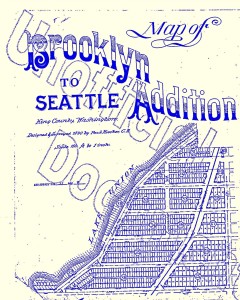
West of the university campus, the neighborhood had been platted as Brooklyn in 1890.
In the early 1900s the term “University District” had not yet come into use. Brooklyn, as the neighborhood west of the university was called by its developer’s plat name, was very much a frontier village as it was without paved streets, water or electric service, and there was little commercial development.
Seattle was officially founded in 1852 at what is now downtown, where Arthur Denny named the first streets. The city grew by fits and starts, as there were some setbacks such as the Puget Sound Indian War and some economic depressions.
The City of Seattle had a sudden population increase due to the Yukon Gold Rush of 1897, but as of 1900 there were still very few people living in the northeast areas of what is now Ravenna, the University District, Sand Point and Wedgwood. The University of Washington had moved from downtown to its present site in 1895, but the student enrollment was small and the campus was undeveloped.
Charles B. Kittredge was sixty years old in 1902 when he moved his family to Brooklyn/the University District, but Kittredge was still vigorous and seemed ready to start a new life in the “frontier town” of Brooklyn. He jumped right into civic affairs and became one of the movers and shakers in the University District for the next 25 years. Like many others who moved to Seattle in its growth years, Kittredge became involved in real estate and in “boosterism” of his new community.
The AYP Exposition of 1909 causes the formation of the University District
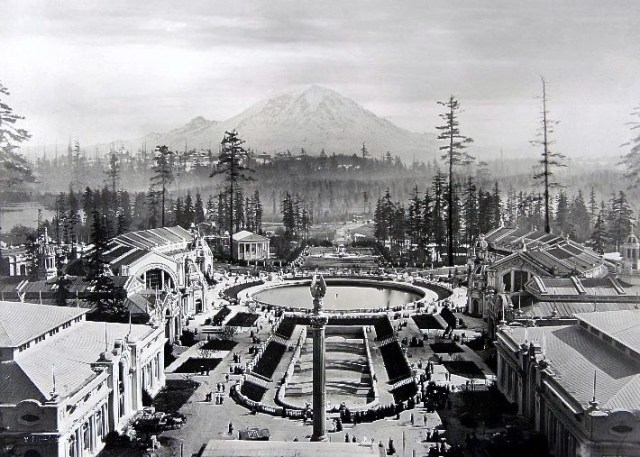
The Alaska-Yukon-Pacific Exposition on the campus of the University of Washington in 1909 had many temporary buildings. But it was the beginning of a site plan for the campus and some features were retained, such as the pool on Rainier Vista which the landscape architects created.
In his adopted city of Seattle Charles Kittredge advertised himself as a real estate agent. He became very active in promoting business development and street improvements in advance of the Alaska-Yukon-Pacific Exposition on the campus of the University of Washington in 1909. The AYP Exposition of 1909 was the turning point which helped create the University District and which opened up northeast Seattle to grow in population. Then when its new bridge opened in 1919, the University District became the gateway between downtown and the northeast Seattle areas.
Boosterism for a bridge
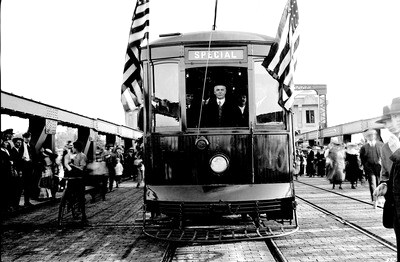
The Mayor of Seattle, Ole Hanson, drove a streetcar to open the new University Bridge on July 1, 1919. Photo 12660 of Seattle Municipal Archives.
Charles Kittredge became best-known as an advocate for the University Bridge to be built. He acquired a powerful ally in the campaign after writing a letter to a friend, John Reid, back in Minnesota, encouraging Reid to migrate West as the Kittredge family had done.
After coming out to Seattle, in 1917 John Reid founded the University District Herald, a free weekly newspaper which was supported entirely by advertising. One of Reid’s goals was to use the newspaper to promote civic projects and concerns, so he essentially used the paper as a lobbying platform for the University Bridge project. Then he and Charles Kittredge celebrated their accomplishment together when the bridge was built in 1919. (See source list at the end of this article for links to info about John Reid.)
The activities of the Kittredge family extend out to Wedgwood
Charles Kittredge was still active in the University District into the 1920s when he was more than eighty years old. Some of his involvements were to advocate for the University Branch Library to be built, and participation in the Seattle branch of the Grand Army of the Republic.
The Grand Army of the Republic was an organization of Union veterans of the Civil War. In Seattle, GAR members helped lead school programs on Decoration Day (Memorial Day, May 30th) and they promoted patriotism by leading parades on the Fourth of July. Charles Kittredge is buried in Seattle’s GAR Cemetery to the north of Lake View Cemetery.
The four unmarried Kittredge daughters, Susie, Alice, Frances and Marguerite, all worked as teachers and two of the women took librarianship courses as well. Alice Kittredge spent the rest of her career at the Green Lake and University Branch Libraries.
In the early 1900s banks were considered risky because there was no insurance on the accounts. It was very common to put savings into land as a safer investment, in hopes that the properties would increase in value. In the early 1900s the names of the Kittredge daughters, including the eldest, W.T. Lopp’s wife Ellen Kittredge Lopp, began appearing on land transactions in northeast Seattle, perhaps guided and encouraged by their father to invest in this way.
Before the year 1910, Ellen Lopp and Alice Kittredge became the owners of a section of undeveloped land along 35th Ave NE in Wedgwood, present site of the medical-dental buildings from 8010 to 8044 35th Ave NE, and up to the corner of NE 82nd Street where the Seattle Audubon Society office is at 8050 35th Ave NE.
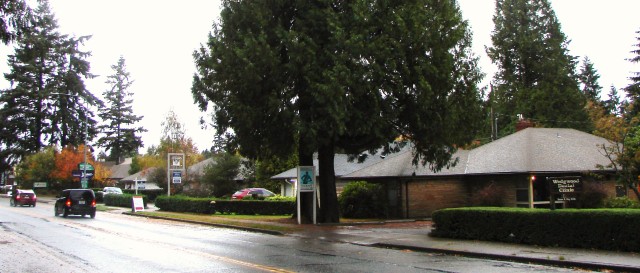
Albert Balch, the developer of Wedgwood, bought this strip of land from the Kittredge sisters and built a row of office buildings on 35th Ave NE.
From Kittredge to Balch
The Kittredge sisters never developed their land in what is now Wedgwood and they seemed to just be holding it as a savings account. What is now Wedgwood, was mostly undeveloped. Wedgwood did not exist as a Seattle neighborhood name until after 1941 when developer Albert Balch began building cottage-like houses which appealed to young couples. The first Wedgwood plat, a group of 200 houses, was on the west side of 35th Ave NE between NE 80th to 85th Streets.
With the boom in the housing market in the years after the end of World War Two in 1945, Balch expanded into more and more nearby land areas. He was successful in buying sections of property from long-time landholders who, like the Kittredge sisters, had not developed it and did not live there.
The Kittredge women finally sold their lots to Albert Balch on July 18, 1946, after holding the properties for nearly forty years. Their properties were on the east side of 35th Ave NE in the block from NE 80th to 82nd Streets, not including the site of Wedgwood Presbyterian Church at the corner of NE 80th. Balch then platted the area on the east side of 35th Ave NE as Balch’s Wedgwood Park, for another group of houses.

The grantor-grantee index shows a sale of property from Alice F. Kittredge to Albert S. Balch on July 18, 1946 (third line from the bottom of the page.) Property records at the Puget Sound Regional Archives, Bellevue, WA.
The Kittredge-to-Balch transaction did not include the present site of Wedgwood Presbyterian Church at 8008 35th Ave NE. The house of the previous owner, Andrew Larsen, was on that corner which he had owned since the early 1900s. In the 1940s the church purchased the site of Larsen’s house and planned to build their new building, to move their church from its previous location at the corner of NE 95th Street.
Since the properties sold to him by the Kittredge sisters faced the arterial 35th Avenue NE, Balch built commercial buildings there. He wanted Wedgwood to have a range of services including stores and offices, so he built a row of medical-dental buildings. The buildings were designed by Grainger & Thomas, the same architectural firm Balch had worked with for the original plat of Wedgwood houses in the early 1940s. The medical-dental buildings were constructed in the period 1948-1952.
From Balch to Birds
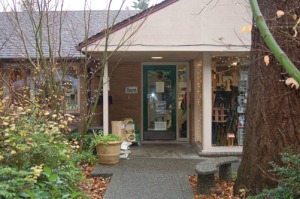
The Seattle Audubon Nature Shop at 8050 35th Ave NE in Wedgwood is in the former office of Albert Balch.
At the corner of NE 82nd Street, Balch built his own office at 8050 35th Ave NE in 1948, and he kept that same office for the rest of his career. After Balch’s death in 1976, another real estate company, Eastman, used the building at 8050 35th Ave NE until Seattle Audubon Society and Nature Shop acquired it.
For the real estate arm of his business, Balch expanded next door to 8044 35th Ave NE. That is the reason for the shared parking lot with 8050, and is the reason for the C-shaped sign in front of the 8044 building. Balch had purchased the right to use the brand name Crawford & Conover for his real estate sales outlet and put that name on the sign. It was an old Seattle name which he thought would lend prestige to the business.
UPDATE: In January 2018, Maid in the Northwest moved out of the 8044 building. A developer bought the site and demolished the building and its C-shaped sign. A cluster of townhouses was bult there.
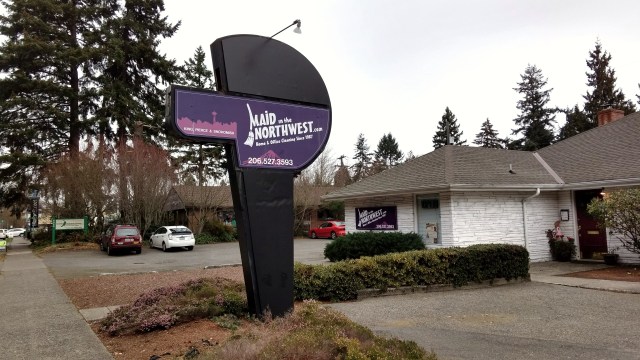
Balch’s real estate office at 8044 35th Ave NE had this C-shaped sign out front for Crawford & Conover, the brand name of his real estate division. The building and its sign were demolished in 2018. At left is the brick building at 8050 35th Ave NE (corner of NE 82nd) which Balch used for his own office, now the site of Seattle Audubon Society’s office and nature shop. Photo by Valarie.
Sources:
UniverCity, the City Within a City, by Roy G. Nielsen, 1986. Seattle Public Library 917.9777.
Large Animal Research Station, Fairbanks, Alaska.
Bureau of Land Management, homestead claim of Charles B. Kittredge, Minnesota.
Census listings – HeritageQuest via the Seattle Public Library.
City directory listings – Polk Directories, Seattle Municipal Archives on the third floor of City Hall, Seattle.
Civil War Index, 46th Massachusetts Infantry.
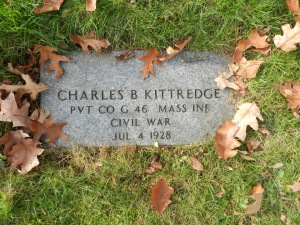
Grave Marker of Charles B. Kittredge in the Grand Army of the Republic Cemetery, Seattle. Photo courtesy of Find A Grave.com
Find-A-Grave.com, gravesite of Charles B. Kittredge, Grand Army of the Republic Cemetery, Seattle.
HistoryLink Essays:
#7197 John Hendrik Reid (1873-1960)
#8774 Seattle races to complete infrastructural improvements needed for June opening of the AYP Exposition in May 1909.
King County General Index, grantor-grantee index of 1941-1946, Puget Sound Regional Archives, Bellevue, WA.
News articles:
Kittredge Funeral, North End Civic Leader, Seattle Daily Times, July 5, 1928, page 2.
William T. Lopp, Pioneer Alaskan Educator, Seattle Daily Times, April 11, 1939, page 15.
Raising Reindeer, Alaska Dispatch News, December 24, 2014.
Seattle Department of Transportation (SDOT): Here is a summary list of Seattle’s bridges and their opening dates.
University of Washington Special Collections: Charles B. Kittredge Papers, including correspondence, speeches, writings, reports, etc., primarily relating to Kittredge’s efforts to promote improvements in Seattle’s University District, Manuscript Collection Number 4542. Donated by Alice F. Kittredge in January 1956.

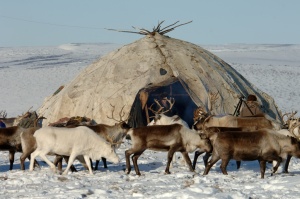
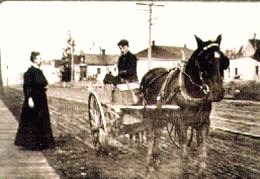
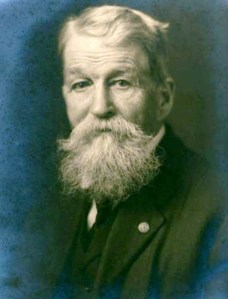
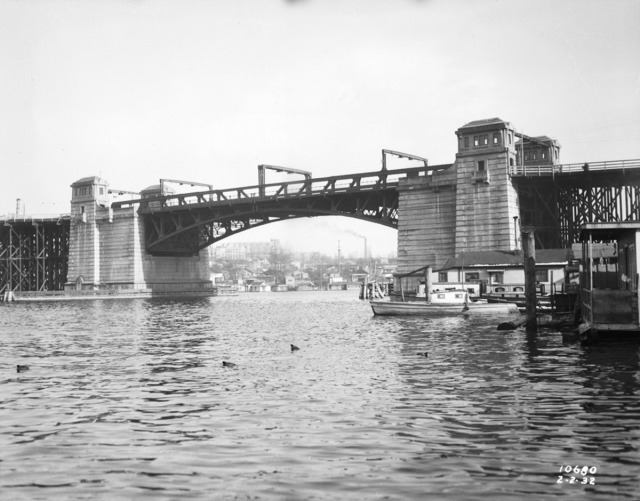
That is an amazing tale. It weaves from civil war Minnesota to the the modern day Seattle Audubon Society. What a great story!
Thanks! I am glad you enjoyed the story, and I am pleased that you followed the thread which, as you say, started with Kittredge in the Civil War, then homesteading in Minnesota and ended up out here! I got onto this story by accessing property records which showed that Alice Kittredge and her sister Ellen Lopp had owned the site on 35th Ave NE at the corner of NE 82nd Street. I followed the chain of ownership which showed that they sold it to Albert Balch, where he built his real estate office in Wedgwood.
Pingback: HARD TIMES, WALKABOUT ON THE LYLE CONVICT ROAD - Meandering through the PrologueMeandering through the Prologue